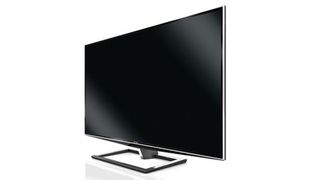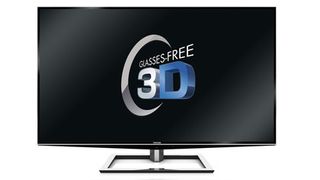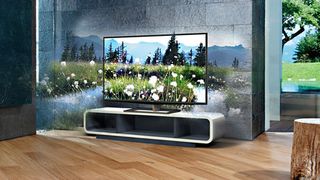Why you can trust TechRadar
Hmm. Should we start with the Toshiba 55ZL2's glasses-free 3D abilities here, or its 4K ones? Let's get the bad news out of the way first and go for the glasses-free 3D.
Actually, referring to the Toshiba 55ZL2's 3D performance as the bad news is a bit harsh, because in many ways its 3D images are many times better than we'd expected them to be.
For starters, you don't see the overt vertical 'seams' in the 3D image that were once visible in early pre-production models whenever you moved your head even slightly away from a viewing sweet spot.
There's also much more sharpness and detail in the glasses-free 3D images than there was in the version of the set we saw at CES back in January.
Motion is handled surprisingly well, given how much strain the TV's processing systems are being put under by having to handle up to nine viewing spots. There's minimal judder or blur to spoil the 3D effect.

Perhaps because of this, the glasses-free 3D images also appear to have more sense of depth to them than they did during previews.
And then, of course, there's the simple fact that you're watching 3D pictures without the encumbrance of any 3D glasses. This is a startlingly liberating experience, especially if you've watched a few hours of 3D movie content while wearing glasses in the past.
It also feels much more natural and much less tiring than wearing active shutter glasses, and enables you to enjoy essentially the same levels of brightness and colour saturation that you get while watching 2D TV and films.
There are three big problems with the Toshiba 55ZL2's glasses-free 3D experience, though. First, objects in the distance of 3D images look so soft relative to foreground objects that they at times look out of focus.
Second, although it's much improved from early pre-production samples, you are still regularly slightly aware of the physical structure of the lenticular lenses creating the 3D picture. This appears as a faint straight line structure or, in one quite large patch of our test screen, as a really quite distracting wavy line structure. Thank goodness this waviness does not cover the whole screen, or else we'd have a genuine nightmare on our hands.

The third issue with the Toshiba 55ZL2's glasses-free 3D images is that you have to sit really, really still. If you don't - if you move your head position by as little as six inches left or right - the image drastically loses its focus and suddenly suffers heavy degrees of crosstalk.
Keep moving in the same direction and you'll eventually get to another 'sweet spot' and it will all click back into focus again. But the bottom line is that by the time you add the need to sit stock still to the visible line structure and blurry backgrounds, you've got just too many distractions to enable you to fully engage with what you're watching.
You can and will often sit there marvelling at the technology that makes glasses-free 3D possible at all - especially given how far Toshiba has brought things on from its pretty disastrous pre-production samples. But you won't so readily find yourself getting lost in the 3D film you're watching, and that, surely defeats the entire purpose of 3D.
4K picture
Right, 4K. As expected, it's here where, for us, the Toshiba 55ZL2 really starts to justify its scary price. Firing up the special shiny 4K server box Toshiba provided us with to watch its 'showreel' of custom-shot 4K content instantly caused our jaws to dangle open in awe.
The native 4K pictures on show are quite simply the finest images ever seen on a TV. Period. The star of the show, of course, is the astonishing amount of detail. You can see leaf details in trees, ripple details in water, skin details on people, texture details in clothing, masonry detail in buildings and so on and so forth that you can't get even close to seeing with normal HD footage.
What's more, this extreme detail is accompanied by complete clarity - by which we mean there's not a trace of video noise of any sort (unless you get stupidly close to the screen, at which point you can just make out a faint honeycomb structure presumably caused by the 3D filters).
Seeing all this groundbreaking clarity and detailing writ large across a 55-inch screen is a stunning experience that turns watching TV into something akin to looking through a window at the real world. Basically, from this point on we'll never be able to feel quite so excited by normal Full HD pictures again.
The tragedy is, of course, that most people will never be able to experience this stunning 4K video for themselves at home even if they buy a Toshiba 55ZL2, on account of its apparent inability to receive 4K via its HDMI.
Sure, the 4K images produced from digital photos via the USB ports also look absolutely incredible - so much so that well-heeled photography enthusiasts might see this as reason enough to splurge seven grand on a TV.
But for most folk, the decision over whether to spend so much will have to boil down to how good the TV is at upscaling HD sources to its 4K screen.
Feeding the Toshiba 55ZL2 a series of our most-watched Blu-rays and a couple of HD channels from our Sky HD receiver, it's a major relief to find that the TV's upscaling abilities are indeed rather good. HD pictures look slightly crisper and more 'dense', for want of a better word, than they do on normal Full HD scenes.

What's more, the Cevo Engine system is powerful enough to achieve this HD to Quad HD remapping without generating unpleasant amounts of processing noise. So long as you don't feel tempted to push the Resolution+ system any higher than its '3' setting, at any rate.
To be clear about this, upscaled HD images don't look anything like as mesmerisingly brilliant as native 4K sources do. But there is a sense of resolution enhancement that you don't get with even the best Full HD TVs, so it's possible some people will consider this reason enough to spend £7k (about $11k) on a TV.
Even the Cevo Engine struggles to convert standard definition sources to the Toshiba 55ZL2's 'Quad HD' resolution, though.
Because while good quality DVDs just about survive the upscaling journey, standard definition broadcasts from the TV's own tuners tend to collapse into a mushy, noisy mess. To be honest this doesn't come as much of a surprise, given just how many extra pixels of picture information the processing is having to add, but it certainly underlines the point that the 55ZL3 is a next-generation TV that's left the standard definition world far behind.
General picture
Shifting our attentions finally to other aspects of the Toshiba 55ZL2's picture performance not directly related to its 4K or glasses-free 3D capabilities, the set turns out to be very accomplished.
Black level response, for instance, is very good for an Edge LED TV. Dark scenes thus generally look natural and engaging, despite there being an occasional shortage of shadow detail and some occasional evidence of light 'blocking'.
This latter phenomenon finds rectangles of slight extra brightness appearing around bright parts of otherwise dark pictures, and is caused by the way the TV dims groups of its edge-mounted LEDs to enhance black level response.
Keeping the Toshiba 55ZL2's backlight and contrast settings under control can reduce the impact of this problem, and it should be said that it only really happens under fairly extreme contrast conditions, such as where a white title sits at the centre of a black backdrop. But there are one or two much more mainstream Edge LED TVs out there now that handle Edge LED local dimming even more satisfactorily.
The Toshiba 55ZL2's colour reproduction, meanwhile, is excellent too. The range of tones it can deliver is enormous, as is the degree of subtlety with which it can delineate even the tiniest of tonal shifts.
As noted before, you're probably better having a stab at calibrating colours yourself than relying on the auto-calibration system, or you could call in an engineer from the Imaging Science Foundation (ISF) to calibrate the set for you.
But anyway, even using some of the calmer presets without playing around with settings much at all, colours are mostly beautifully handled. The only issue we could find was that skin tones could occasionally look a touch inconsistent.
The Toshiba 55ZL2's motion handling continues the good news. The native response time of the panel is good enough to keep motion blur to a minimum even without the Active Vision M800 motion processing in play.
But if you wish to set this processing to its Standard setting to enjoy a little less judder, you can do so without the picture looking processed. We would strongly recommend, though, that you avoid the overcooked Smooth Active Vision M800 mode.
Aside from the occasional backlight flaws and the standard definition problems noted earlier, the only other problem we had with the Toshiba 55ZL2's mostly excellent (and with native 4K sources, awesome) 2D pictures was that the screen is rather reflective of ambient light in your room. Certainly positioning the set with a direct light source right opposite is not recommended.
AV Technology Contributor
John has been writing about home entertainment technology for more than two decades - an especially impressive feat considering he still claims to only be 35 years old (yeah, right). In that time he’s reviewed hundreds if not thousands of TVs, projectors and speakers, and spent frankly far too long sitting by himself in a dark room.

Forget OLED screens, the iPad could actually get the Calculator app later this year

AMD’s next-gen CPUs set to be Ryzen 9000 – and here’s another clue that Zen 5 launch could be imminent

'In the beginning I didn't want to – my son persuaded me': why Audiovector's Trapeze Reimagined speaker is a 45-year family affair

